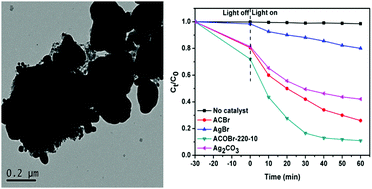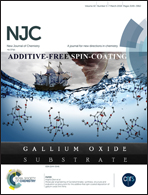Controllable fabrication of a novel heterojunction composite: AgBr and Ag@Ag2O co-modified Ag2CO3 with excellent photocatalytic performance towards refractory pollutant degradation
Abstract
A novel visible-light-driven composite AgBr (15 wt%)/Ag@Ag2O/Ag2CO3 with different weight ratios of Ag2O was successfully fabricated via a facile chemical strategy. The heterojunction composite was characterized in terms of crystallinity, morphology, optical properties and composition. The optimized heterostructured catalyst exhibited superior photocatalytic performance in the degradation of methylene blue (MB) and ciprofloxacin (CIP) compared with the pristine and binary composites. The effects of initial concentration and light intensity were also investigated to study the practical application in the treatment of wastewater. The trapping experiment and ESR spin-trapping analysis verified that the active species of ˙O2− and h+ played a critical role in the degradation of organic pollutants. Moreover, the excellent photocatalytic performance was due to the formation of the heterojunction structure, the strong optical absorption ability and the ultra-fast transfer of electron–hole charge pairs resulting from the introduction of AgBr and Ag@Ag2O nanocomposites. In addition, a possible mechanism for the enhanced photocatalytic performance was proposed. This study gives a new insight into the fabrication of novel heterostructured photocatalysts for the real treatment of robust organic pollutants.



 Please wait while we load your content...
Please wait while we load your content...